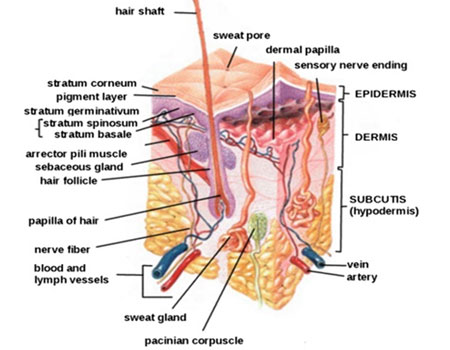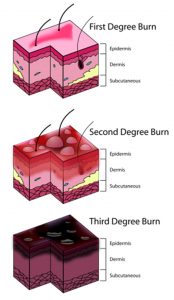7 HGH Benefits for Skin

Human growth hormone provides 7 key HGH benefits for the skin. As the body’s largest organ, the skin makes up roughly 22 square feet totaling about 8 pounds. The skin is made up of three layers of different cells that need replacing on a daily basis, and this is where HGH comes into play. Human growth hormone stimulates the process of cellular regeneration that continues to provide new cells for those which die off and need replacing.
- HGH tells the liver to secrete insulin growth factor 1
- Insulin growth factor 1 promotes the effects of HGH
- HGH and IGF-1 stimulate the body to regenerate and reproduce new cells
The skin is the body’s protective covering performing the following crucial functions:
- Insulating against changes in temperature
- Preventing damaging chemicals from entering the body
- Shielding the blood vessels and organs from the dangerous rays of sunlight
- Manufacturing vitamin D that helps convert calcium into bone
- Provides infection-fighting antibacterial substances
- Contains sensors that provide stimulus to the brain
There are 7 HGH benefits for skin beginning with:
- 1. Cellular Regeneration

As the body’s largest organ, the skin needs the most cells. It contains three layers: the epidermis, dermis, and hypodermis which all require different types of cells:
- Epidermis – keratinocytes make up several layers that grow outward over a period of four to five weeks before they reach the surface and flake away. This dead skin covering is called the stratum corneum. Langerhans cells in the epidermis trigger the immune system to act against viruses and infectious agents. Also in this layer, we find melanocytes, the cells responsible for the pigment melanin that determines skin color.
- Dermis – located below the epidermis, this deeper skin layer consists of collagen and elastin fibers that provide the skin’s elasticity and strength. Blood vessels (containing blood cells also stimulated by HGH) increase blood flow to regulate body temperature. Nerve fibers and receptors relay signals of touch, pain, and temperature to the brain.
- Hypodermis – fat cells in this layer insulate and cushion the body from injury.
Further HGH benefits on skin influence appearance, protection, and healing.
HGH and Collagen
The following HGH benefits for skin may seem as though appearance is the number one positive attribute; however, the difference made here also helps protect the body from injury and potential intrusive viruses and germs.
- 2. Thicker Skin
In the dermis, IGF-1 exerts a synergistic effect with HGH that influences and speeds up the production of collagen which helps to thicken the skin, protecting it from tear and injury.
- 3. Skin Elasticity
Increased collagen brings another positive benefit from HGH – skin elasticity that makes the skin more pliable and resistance to injury.
- 4. Skin Tightening
With the increase in collagen production brought about by the HGH/IGF-1 cellular regeneration process, the skin begins to tighten and firm. This HGH skin tightening resulting from a gradual plumping reverses the effects of sagging and looseness that accompany aging, thinning skin.
When an adult with growth hormone deficiency receives HGH, skin before and after results are noticeable in all three layers of the skin.
HGH and Skin Restoration
The amazing HGH benefits on skin continue with improving the visible signs of wrinkles, stimulating healing, and cellulite reduction:
- 5. Reduced Wrinkles
As HGH begins to exert its effects on both the dermis and the epidermis, the tightening and firming processes start to reduce the visible appearance of wrinkles. Fine lines start to disappear as increased collagen plumps the skin. Some people like to take pictures documenting their progress with HGH wrinkles before and after treatment.
- 6. Wound Healing
HGH benefits for the skin when it comes to healing occurs in three stages between the cells of the epidermis and dermis:

- a) Inflammatory cells reach the injured area where a blood clot forms, and as the keratinocytes begin to migrate through the wound, they initiate a process called reepithelialization.
- b) The formulation of granulation tissue occurs as the keratinocytes proliferate (again – cellular regeneration stimulated by HGH) from inside the wound and around the edges to restore the dermis.
- c) Remodeling of the granulation tissue occurs as the density of dermal cells decline along with vascular regression.
HGH can accelerate skin graft healing in burn victims. Because the skin of older adults tends to become thin due to decreased cellular regeneration and a lack of collagen, skin tears and injuries take longer to heal. HGH therapy benefits reduce the healing time, speeding up recovery.
- 7. Cellulite
Different factors fuel the reduction in the appearance of cellulite:
- a) The fat deposits under the skin that make up cellulite start to disappear and HGH stimulates the metabolism to utilize and burn stored body fat for fuel.
- b) Connective tissue called septra that surrounds the fat, compresses them in a way that forms the cottage cheese appearance of cellulite until HGH reverses this process.
- c) Growth hormone deficiency reduces muscle tone and metabolism, increasing the appearance of visible cellulite. HGH therapy improves metabolism and muscle tone, reducing the appearance of cellulite.
For additional information about the benefits of HGH for the skin, contact the hormone specialists at HT Medical Center for a free consultation.

















